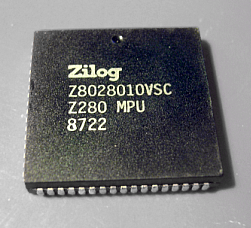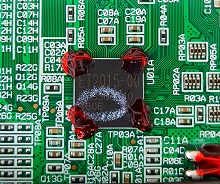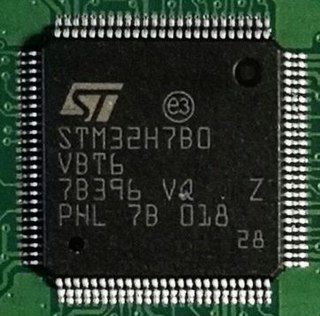
The Zilog Z80 is an 8-bit microprocessor designed by Zilog that played an important role in the evolution of early computing. Software-compatible with the Intel 8080, it offered a compelling alternative due to its better integration and increased performance. The Z80 boasted fourteen registers compared to the 8080's seven, along with additional instructions for bit manipulation, making it a more powerful chip.

A universal asynchronous receiver-transmitter is a peripheral device for asynchronous serial communication in which the data format and transmission speeds are configurable. It sends data bits one by one, from the least significant to the most significant, framed by start and stop bits so that precise timing is handled by the communication channel. The electric signaling levels are handled by a driver circuit external to the UART. Common signal levels are RS-232, RS-485, and raw TTL for short debugging links. Early teletypewriters used current loops.

The Intel 8085 ("eighty-eighty-five") is an 8-bit microprocessor produced by Intel and introduced in March 1976. It is the last 8-bit microprocessor developed by Intel.

AVR is a family of microcontrollers developed since 1996 by Atmel, acquired by Microchip Technology in 2016. These are modified Harvard architecture 8-bit RISC single-chip microcontrollers. AVR was one of the first microcontroller families to use on-chip flash memory for program storage, as opposed to one-time programmable ROM, EPROM, or EEPROM used by other microcontrollers at the time.

The Athlon 64 is a ninth-generation, AMD64-architecture microprocessor produced by Advanced Micro Devices (AMD), released on September 23, 2003. It is the third processor to bear the name Athlon, and the immediate successor to the Athlon XP. The Athlon 64 was the second processor to implement the AMD64 architecture and the first 64-bit processor targeted at the average consumer. Variants of the Athlon 64 have been produced for Socket 754, Socket 939, Socket 940, and Socket AM2. It was AMD's primary consumer CPU, and primarily competed with Intel's Pentium 4, especially the Prescott and Cedar Mill core revisions.
Serial Peripheral Interface (SPI) is a de facto standard for synchronous serial communication, used primarily in embedded systems for short-distance wired communication between integrated circuits.

The Zilog Z8000 is a 16-bit microprocessor designed by Zilog in early 1979.
4-bit computing is the use of computer architectures in which integers and other data units are 4 bits wide. 4-bit central processing unit (CPU) and arithmetic logic unit (ALU) architectures are those that are based on registers or data buses of that size. A group of four bits is also called a nibble and has 24 = 16 possible values.

The Zilog Z180 is an 8-bit microprocessor designed by Zilog as a successor to the Z80. It is compatible with the large base of software written for the Z80. The Z180 family adds higher performance and integrated peripheral functions like clock generator, 16-bit counters/timers, interrupt controller, wait-state generators, serial ports and a DMA controller. It uses separate read and write strobes, sharing similar timings with the Z80 and Intel processors. The on-chip memory management unit (MMU) has the capability of addressing up to 1 MB of memory. It is possible to configure the Z180 to operate as the Hitachi HD64180.

The HD64180 is a Z80-based embedded microprocessor developed by Hitachi with an integrated memory management unit (MMU) and on-chip peripherals. It appeared in 1985. The Hitachi HD64180 "Super Z80" was later licensed to Zilog and sold by them as the Z64180 and with some enhancements as the Zilog Z180.

The Zilog Z280 is a 16-bit microprocessor designed by Zilog as an enhancement of the Zilog Z80 architecture and integrating improvements from the abandoned Zilog Z800 project. First introduced in July 1987, the Z280 is considered to be a commercial failure.

The Zilog eZ80 is an 8-bit microprocessor designed by Zilog as an updated version of the company's first product, the highly-successful Zilog Z80. The eZ80 is binary compatible with the Z80, but operating almost three times faster at the same clock frequency.

The Low Pin Count (LPC) bus is a computer bus used on IBM-compatible personal computers to connect low-bandwidth devices to the CPU, such as the BIOS ROM, "legacy" I/O devices, and Trusted Platform Module (TPM). "Legacy" I/O devices usually include serial and parallel ports, PS/2 keyboard, PS/2 mouse, and floppy disk controller.
Double Data Rate 3 Synchronous Dynamic Random-Access Memory is a type of synchronous dynamic random-access memory (SDRAM) with a high bandwidth interface, and has been in use since 2007. It is the higher-speed successor to DDR and DDR2 and predecessor to DDR4 synchronous dynamic random-access memory (SDRAM) chips. DDR3 SDRAM is neither forward nor backward compatible with any earlier type of random-access memory (RAM) because of different signaling voltages, timings, and other factors.
Alchemy is a family of ultra low power embedded microprocessors originally designed by Alchemy Semiconductor for communication and media devices. Alchemy processors are SoCs integrating a CPU core, a memory controller, and a varying set of peripherals. All members of the family use the Au1 CPU core implementing the MIPS32 instruction set by MIPS Technologies.
Tolapai is the code name of Intel's embedded system on a chip (SoC) which combines a Pentium M (Dothan) processor core, DDR2 memory controllers and input/output (I/O) controllers, and a QuickAssist integrated accelerator unit for security functions.

STM32 is a family of 32-bit microcontroller integrated circuits by STMicroelectronics. The STM32 chips are grouped into related series that are based around the same 32-bit ARM processor core: Cortex-M0, Cortex-M0+, Cortex-M3, Cortex-M4, Cortex-M7, Cortex-M33. Internally, each microcontroller consists of ARM processor core(s), flash memory, static RAM, debugging interface, and various peripherals.

LPC is a family of 32-bit microcontroller integrated circuits by NXP Semiconductors. The LPC chips are grouped into related series that are based around the same 32-bit ARM processor core, such as the Cortex-M4F, Cortex-M3, Cortex-M0+, or Cortex-M0. Internally, each microcontroller consists of the processor core, static RAM memory, flash memory, debugging interface, and various peripherals. The earliest LPC series were based on the Intel 8-bit 80C51 core. As of February 2011, NXP had shipped over one billion ARM processor-based chips.

The P8000 is a microcomputer system developed in 1987 by the VEB Elektro-Apparate-Werke Berlin-Treptow „Friedrich Ebert“ (EAW) in the German Democratic Republic. It consisted of an 8-bit and a 16-bit microprocessor and a Winchester disk controller. It was intended as a universal programming and development system for multi-user/multi-task applications. The initial list price of the P8000 was 172,125 East German marks.

I3C, also known as SenseWire, is a specification to enable communication between computer chips by defining the electrical connection between the chips and signaling patterns to be used. Short for "Improved Inter Integrated Circuit", the standard defines the electrical connection between the chips to be a two wire, shared (multidrop), serial data bus, one wire (SCL) being used as a clock to define the sampling times, the other wire (SDA) being used as a data line whose voltage can be sampled. The standard defines a signalling protocol in which multiple chips can control communication and thereby act as the bus controller.















